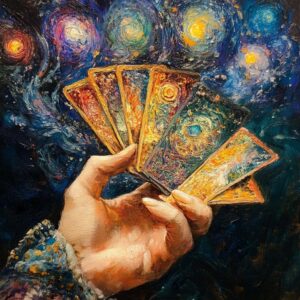
A pentagram is a geometric shape that forms a star with five identical triangles. The word "pentagram" comes from the Greek word "pentagrammon," meaning "five lines." The pentagram is one of the geometric shapes where the golden ratio naturally appears.
Overall, the pentagram is a multifaceted symbol with a deep history and diverse interpretations across different cultures and belief systems. Its mathematical elegance and rich symbolic meanings continue to captivate and inspire people around the world.
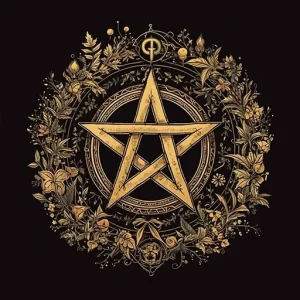
The pentagram began to be used symbolically as early as ancient Greece and Babylon, where it was attributed with magical abilities. To this day, the pentagram serves as a symbol of faith among modern witches, similar to the way Christians use the cross and Jews use the Star of David.
The earliest known use of the pentagram shape can be found in Mesopotamian writings around 3000 BCE. The Sumerian pentagram, with two of its points facing upward, was used to represent various words. In Babylonian culture, the position of the pentagram’s points had astrological significance, representing the five known planets at the time—Jupiter, Mercury, Mars, Saturn, and Venus, with the kingdom of heaven above. In early Sumerian diagrams, the pentagram was used to denote words like "corner" or "angle." Some also associate the pentagram with King Solomon.
The pentagram is linked to the planet Venus and the goddess Venus, who represents this celestial body. This connection is rooted in ancient astronomical discoveries, where astronomers observed that the movement of Venus forms a shape resembling a pentagram. The pentagram is also associated with the Roman god Lucifer, who was seen as the god of the morning and knowledge.
In Christianity, the pentagram was used as a symbol representing the five senses, and it also symbolized the five wounds of Christ’s crucifixion.
The Pythagoreans called the pentagram "Hygieia," meaning health, after the Greek goddess of health, Hygieia, who was the granddaughter of Apollo, the sun god. They viewed the pentagram as a symbol of mathematical perfection. The pentagram in Agrippa's work, used by the Pythagoreans, was inscribed with Greek letters at its points. The ancient Pythagorean pentagram was typically drawn with two points facing upward.
During the Middle Ages, the pentagram with five points was used by the Neo-Pythagoreans to represent the five classical elements: water, earth, fire, air, and spirit. The points were marked with the Greek letters υ-γ-ι-ε-α, and the order and direction (clockwise or counterclockwise) could vary, as could the position of the first point.
Heinrich Cornelius Agrippa, a German astrologer and alchemist, recognized that the letters used by the Pythagoreans were actually the first letters of the five elements.
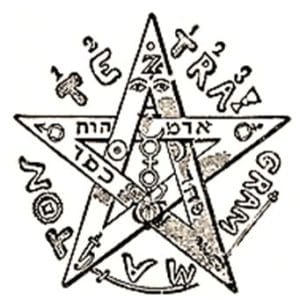
In Judaism, the pentagram was one of the symbols of Jerusalem between 300 and 150 BCE. The pentagram appears on jar handles from the Hasmonean period. You can also find the pentagram depicted in synagogues and on tombstones in medieval Europe. The association of the Star of David with Judaism began in the Middle Ages. In 1354, Emperor Charles IV granted the Jews of Prague the right to raise a flag. The Jews chose the Star of David as their symbol, but until then, pentagrams were often depicted alongside Stars of David without distinction between the symbols.
The pentagram appears on the shield of Sir Gawain in the 14th-century poem "Sir Gawain and the Green Knight." The five points of the pentagram hold different meanings: each point represents one of the five senses; each point represents one of the five fingers; each point symbolizes the five joys of Mary in Jesus’ life, which are the Annunciation, the Nativity, the Resurrection, the Ascension, and the Assumption of Mary; and the five virtues that Gawain strives to embody: honesty, friendship, purity, courtesy, and compassion.
The pentagram also represented the four cardinal directions, with the fifth point, pointing upward, symbolizing the spirit or the soul.
In German folklore, the pentagram is referred to as a "pentacle." In Goethe's Faust (1808), the pentagram is mentioned as preventing Mephistopheles from leaving the room, as the belief was that the pentagram was enchanted. It was crucial to always keep the star with five points upright, with the upper triangle pointing toward the heavens, the seat of wisdom. If the star is inverted, deviation and evil are the result.
Mephistopheles:
"I must admit a small obstacle prevents me from leaving,
That is, the pentagram at the threshold."
Faust:
"And from this pentagram you shrink?
Tell me, you son of hell,
How did you enter, if this blocks your way?"
Mephistopheles:
"Observe it closely, it is not drawn well:
One of its angles, pointing outward,
Is, as you can see, slightly open."
(Faust, translated by Yaakov Cohen, Schocken Publishing, 1943)
As seen in the poem above, by the mid-19th century, a further distinction developed regarding the orientation of the pentagram. When one point faces upward, it symbolizes the dominance of spirit over the four elements of matter, representing goodness. The author Eliphas Levi declared the pentagram evil whenever the symbol was depicted otherwise. When the pentagram is inverted, with two points facing upward, it symbolized evil and Satan, drawing power from the underworld, illustrating the triumph of matter over spirit. The inverted pentagram became a symbol of black magic.
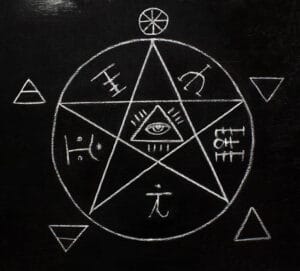
In China, the five phases of Wu Xing—Wood, Fire, Earth, Metal, and Water—form a pentagram. These elements are similar to the ancient Greek elements but emphasize their cyclical transformation. Each element generates or overcomes the next in a continuous cycle, symbolizing the dynamic and interconnected nature of the universe. The pentagram in this context represents the balance and interaction between these fundamental forces, which are essential in various aspects of Chinese philosophy, medicine, and metaphysics.
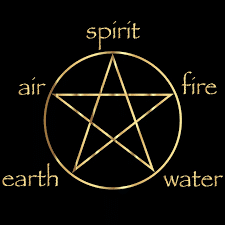
In Renaissance Christianity, the pentagram was often associated with the symbolism of hidden or esoteric knowledge. Its primary use continued the ancient Babylonian tradition, where it was intended to protect against evil forces. Eliphas Levi stated that "the pentagram expresses the domination of the mind over the elements. When used correctly, it compels the spirits of the air, the ghosts of fire, the phantoms of water, and the spirits of the earth to remain dormant, allowing the soul to rule."
In this Renaissance spirit, the Hermetic Order of the Golden Dawn developed the use of the pentagram in various rituals. The pentagram is still used by those who practice the magic of the Golden Dawn.
Aleister Crowley used the pentagram in Thelema, particularly the inverted pentagram, which represents the descent of spirit into matter. Crowley opposed his former colleagues in the Golden Dawn, who, following Levi, viewed the inverted pentagram as a symbol of evil. Crowley associated it with the triumph of matter over spirit.
In 1909, Arthur Edward Waite published the tarot deck he created with Pamela Colman Smith, who illustrated the cards under his guidance. Waite was a member of both the "Hermetic Order of the Golden Dawn" and the "Rosicrucian Order" in England. After being involved in these two orders, Waite founded the "Fellowship of the Rosy Cross." These secret societies operated in England at the end of the 19th and the beginning of the 20th centuries, and his tarot deck was designed according to the principles, teachings, and symbols of these orders. The importance of this deck lies in the fact that it was the first time that works describing symbols from secret orders were revealed to outsiders who were not members of the order.
In the tarot cards, the pentagram can be found in the suit of Pentacles, and an inverted pentagram appears on the Devil card. In neo-pagan symbolism, the pentagram represents the four classical elements and the fifth element, the spirit, in neo-pagan belief. The circle surrounding the pentagram unites all the elements to bring them into harmony. Many neo-pagans, especially modern witches, use the pentagram as a symbol of hope, similar to symbols used in other religions.
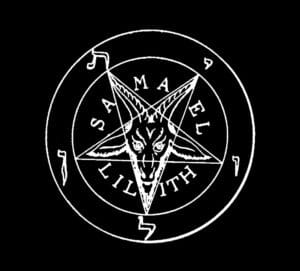
Satanists use the Pythagorean pentagram with two points facing upward, typically encircled by two rings. This symbol, often referred to as "Tartarus" in Christian terminology, represents hell, where fallen angels are said to be bound in chains. In this version of the pentagram, the ancient Greek letters of the Pythagoreans are replaced with Hebrew letters spelling "Leviathan," a sea monster symbolizing chaos and rebellion. For Satanists, the pentagram serves as a symbol of defiance and opposition to traditional religious beliefs.
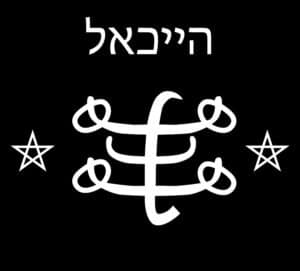
The official symbol of the Bahá'í Faith is the five-pointed star, known as the "Haykal," meaning "temple" or "sanctuary." The Haykal, a pentagram, was adopted by Bahá'u'lláh and established as a symbol by the Báb. The Báb would write letters, prayers, and other writings in the shape of the star. The Haykal symbolizes the bodies of the prophets, referred to as the "Manifestations." This symbol holds profound significance within the Bahá'í Faith, representing the divine connection between the Manifestations of God and their spiritual mission.
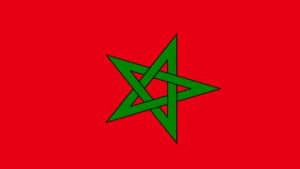
Another modern use of the pentagram is found in national flags. The flag of Morocco features a pentagram that symbolizes the connection between God and the state. Ethiopia has also adopted the pentagram on its flag. Some argue that the pentagrams on the flags of both Morocco and Ethiopia are, in fact, symbols of King Solomon. Additionally, the flag of the Dutch city of Haaksbergen includes a pentagram as well. These uses of the pentagram in national and municipal symbols reflect its enduring significance and its association with various cultural and religious meanings.

The Druze flag symbolizes and represents the Druze faith. There are two different forms of the Druze flag: one is rectangular, and the other is shaped like a five-pointed star, the pentagram. The star is colored in five different hues, each symbolizing a specific value: Red for bravery, courage, and love; Yellow for knowledge, enlightenment, and wheat; Green for earth and nature; Blue for patience, forgiveness, brotherhood, sky, and water; White for peace and purity.
Additionally, the pentagram was also the symbol of the Marxist-Leninist terrorist group, the Red Brigades, as well as the Marxist-Leninist terrorist group Baader-Meinhof. These groups adopted the pentagram as a symbol of their revolutionary and militant ideologies.

Orit Raphael, Tarot Reader for Personal Guidance, Insights, and Messages